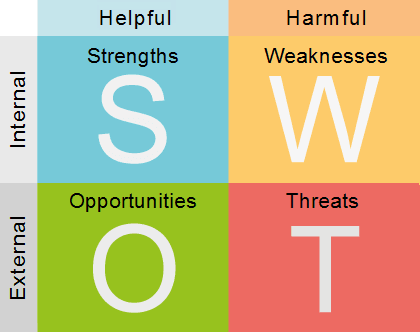The S.W.O.T analysis is a technique used for analysing the strengths, weaknesses, opportunities and threats that a business faces.
Strengths and weaknesses examine the internal pros and cons, while opportunities and threats examine the external pros and cons.
What are your strengths?
What advantage(s) do you have over competitors?
What features are positively unique about your business?
What do others (customers or competitors for example) see as your strength?
Write a list of the positive features of your business and go from there. Anything special that you offer or a positive image you may convey.
What are your weaknesses?
What do others see as weak about your business?
In which areas do you need to make improvements?
What should you avoid?
Is the quality of your product up to the market standard?
Do you have a bad reputation?
Are you or your workforce up to par in terms of experience and expertise?
Look at the aspects of your business that need improvement.
What are your opportunities?
Where are the opportunities?
Are there any new trends in the market that you could benefit from? What are they?
How can you create your own opportunities?
Are there new markets available overseas – maybe you can now export products?
Is there a new market segment or have you discovered a niche market?
Look at your strengths; see how they can aid the opportunities. What about the weakness, once you change those negatives how can you benefit from them?
What are the threats that face you?
What challenges awaits you?
Do you have any critical weaknesses?
Are there new tax laws, for example?
Look at the changes in the industry and what challenges these pose for you. Can you meet them head on, if not what’s the next best alternative? Do your competitors have new innovation or technology that you don’t?
A S.W.O.T analysis could prove important no matter what stage your business is at. Looking objectively at your business can aid you in making better decisions for growth and improvement.








One Comment